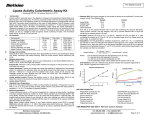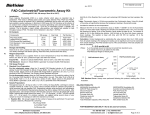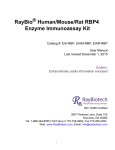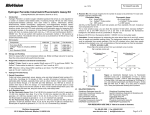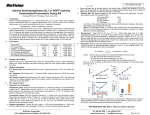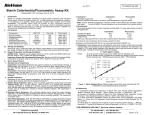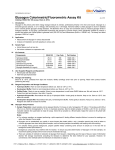Download Data Sheet - BioVision
Transcript
BioVision For research use only rev. 10/13 Pyruvate Kinase Activity Colorimetric/Fluorometric Assay Kit (Catalog #K709-100; 100 assays; Store kit at –20°C) Introduction: Pyruvate kinase (PK, EC 2.7.1.40) is an enzyme involved in glycolysis. It catalyzes the transfer of a phosphate group from phosphoenolpyruvate (PEP) to ADP, yielding one molecule of pyruvate and one molecule of ATP. Lack of pyruvate kinase will slow down the process of glycolysis which causes the disease known as pyruvate kinase deficiency. BioVision provides a simple, direct and automation-ready procedure for measuring pyruvate kinase activity in various biological samples such as blood, tissues, and culture cells, etc. In the assay, PEP and ADP were catalyzed by PK to generate pyruvate and ATP. The generated pyruvate is oxidized by pyruvate oxidase to produce color (λ = 570 nm) and fluorescence (at Ex/Em = 535/587 nm). Since the increase in color or fluorescence intensity is proportional to the increase in pyruvate amount, the PK activity can be accurately measured. The kit detects 0.1 mU pyruvate kinase. II. Kit Contents: I. Cap Code Part Number PK Assay Buffer OxiRed™ Probe PK Enzyme Mix PK Substrate Mix PK Positive Control Pyruvate Standard (100 nmol/µl) 25 ml 200 µl Lyophilized Lyophilized Lyophilized 100 µl WM Red Green Purple Blue Yellow K709-100-1 K709-100-2A K709-100-4 K709-100-5 K709-100-6 K709-100-7 III. Reagent Preparation and Storage Conditions: OxiRed™ Probe: Ready to use as supplied. Allow to come to room temperature before use to melt frozen DMSO. Store at -20°C, protect from light and moisture. Use within two months. PK Substrate Mix, PK Enzyme Mix: Dissolve with 220 µl diH2O. Pipette up and down to completely dissolve. Store at -20°C. Use within two months. PK Positive Control: Dissolve with 100 µl diH2O. Pipette up and down to completely dissolve. Store at -20°C. Use within two months. IV. Pyruvate Kinase Assay Protocol: 1. Standard Curve Preparations: For the colorimetric assay: Dilute the Pyruvate Standard to 1 nmol/µl by adding 10 µl of the Standard to 990 µl of Assay Buffer, mix well. For the fluorometric assay: Dilute the Pyruvate Standard to 1 nmol/µl as for the colorimetric assay. Then dilute the standard another 10-fold to 0.1 nmol/µl by mixing 10 µl with 90 µl of Pyruvate Assay Buffer. Mix well. Add 0, 2, 4, 6, 8, 10 µl of the diluted standard into a series of wells. Adjust volume to 50 µl/well with Assay Buffer to generate 0, 2, 4, 6, 8, and 10 nmol/well of the Pyruvate Standard for the colorimetric assay, or 0, 0.2, 0.4, 0.6, 0.8, and 1.0 nmol/well for the fluorometric assay. 2. Sample and Positive Control Preparations: Serum can be directly added into sample wells. Tissues or cells can be extracted with 4 volumes of the Assay Buffer, centrifuge to get clear extract. Add samples directly into 96 well plate, bring volume to 50 µl/well with PK Assay Buffer. We suggest testing several doses of your sample to ensure the readings are within the linear range. For the positive control (optional), add 5 µl positive control solution to wells (use 0.5 – 2 ul Positive Control for fluorometric assay), adjust volume to 50 µl/well with Assay Buffer. 3. Reaction Mix Preparation: Mix enough reagents for the number of standard and assays to be performed. For each well, prepare a total 50 µl Reaction Mix containing: Pyruvate Kinase Measurement Background Control* Assay Buffer 44 µl 46 µl Substrate Mix 2 µl ----------Enzyme Mix 2 µl 2 µl OxiRed™ Probe** 2 µl 2 µl BioVision Incorporated 155 S. Milpitas Boulevard, Milpitas, CA 95035 USA Note: It is essential to read A1 and A2 in the reaction linear range. It will be more accurate if you read the reaction kinetics. Then choose A1 and A2 in the reaction linear range. Calculation: Subtract 0 standard readings from the standards. Plot the pyruvate standard curve. Apply the ∆A to the standard curve to get B nmol of pyruvate generated between T1 and T2 by PK in the reaction wells. PK calculation: 6. B PK Activity = x Sample Dilution Factor = nmol/min/ml = mU/mL (T2-T1) x V Where: B is the pyruvate amount from pyruvate standard curve (in nmol). T1 is the time of the first reading (A1) (in min). T2 is the time of the second reading (A2) (in min). V is the sample volume added into the reaction well (in ml). Unit definition: One unit of Pyruvate Kinase is the amount of enzyme that will transfer a phosphate group from PEP to ADP, yielding 1.0 µmol of pyruvate per minute at 25°C. Pyruvate Standard Curve PK sample kinetics 1.0mU 1.5 1 OD 570nm 100 Assays 5. OD 570nm Components 4. *Pyruvate in the sample will generate background. If significant amount of pyruvate is in your sample, the background control should be performed. The background readings are then subtracted from your sample readings. ** The fluorometric assay is ~10 times more sensitive than the colorimetric assay. Use 0.4 µl of the probe per reaction to decrease the background reading/increase detection sensitivity significantly. Add 50 µl of the reaction mix to each well containing the pyruvate standard, samples and controls, mix well. Measure OD 570 nm or fluorescence Ex/Em = 535/587 nm at T1 to read A1, measure again at T2 after incubating the reaction at 25°C for 10 - 20 min (or incubate longer time if the PK activity is low in sample) to read A2, protect from light. The signal increase is due to pyruvate generated by PK, ∆A = A2 – A1 0.5 0.8mU 0.6mU 1 0.4mU 0.2mU y = 0.1139x + 0.016 R² = 0.9988 0.5 0mU 0 0 0 5 10 Pyruvate (nmol) RELATED PRODUCTS: Pyruvate Assay Kit Cholesterol Assay Kit Glutathione Kit (GSH, GSSG and Total) Maltose Assay Kit Free Fatty Acid, Triglyceride Assay Kits Glycogen, Starch Assay Kits Ethanol Assay Kit 0 5 10 15 20 Time (min) Lactate Assay Kit Glutamate Assay Kit Glucose, Sucrose, Galactose Assay Kits Ascorbic Acid Assay Kit NAD(P)/NAD(P)H Assay Kit Apoptosis Assay Kits (many) Cell Proliferation Assay Kits FOR RESEARCH USE ONLY! Not to be used on humans. Tel: 408-493-1800 | Fax: 408-493-1801 www.biovision.com | [email protected] Page 1 of 2 BioVision rev. 10/13 For research use only GENERAL TROUBLESHOOTING GUIDE: Problems Cause Solution Assay not working • Use of ice-cold assay buffer • Assay buffer must be at room temperature Samples with erratic readings Lower/ Higher readings in Samples and Standards Readings do not follow a linear pattern for Standard curve Unanticipated results • Omission of a step in the protocol • Refer and follow the data sheet precisely • Plate read at incorrect wavelength • Check the wavelength in the data sheet and the filter settings of the instrument • Use of a different 96-well plate • Fluorescence: Black plates (clear bottoms) ; Luminescence: White plates ; Colorimeters: Clear plates • Use of an incompatible sample type • Refer data sheet for details about incompatible samples • Samples prepared in a different buffer • Use the assay buffer provided in the kit or refer data sheet for instructions • Cell/ tissue samples were not completely homogenized • Use Dounce homogenizer (increase the number of strokes); observe for lysis under microscope • Samples used after multiple free-thaw cycles • Aliquot and freeze samples if needed to use multiple times • Presence of interfering substance in the sample • Troubleshoot if needed • Use of old or inappropriately stored samples • Use fresh samples or store at correct temperatures until use • Improperly thawed components • Thaw all components completely and mix gently before use • Use of expired kit or improperly stored reagents • Always check the expiry date and store the components appropriately • Allowing the reagents to sit for extended times on ice • Always thaw and prepare fresh reaction mix before use • Incorrect incubation times or temperatures • Refer datasheet & verify correct incubation times and temperatures • Incorrect volumes used • Use calibrated pipettes and aliquot correctly • Use of partially thawed components • Thaw and resuspend all components before preparing the reaction mix • Pipetting errors in the standard • Avoid pipetting small volumes • Pipetting errors in the reaction mix • Prepare a master reaction mix whenever possible • Air bubbles formed in well • Pipette gently against the wall of the tubes • Standard stock is at an incorrect concentration • Always refer the dilutions in the data sheet • Calculation errors • Recheck calculations after referring the data sheet • Substituting reagents from older kits/ lots • Use fresh components from the same kit • Measured at incorrect wavelength • Check the equipment and the filter setting • Samples contain interfering substances • Troubleshoot if it interferes with the kit • Use of incompatible sample type • Refer data sheet to check if sample is compatible with the kit or optimization is needed • Sample readings above/below the linear range • Concentrate/ Dilute sample so as to be in the linear range Note: The most probable list of causes is under each problem section. Causes/ Solutions may overlap with other problems. BioVision Incorporated 155 S. Milpitas Boulevard, Milpitas, CA 95035 USA Tel: 408-493-1800 | Fax: 408-493-1801 www.biovision.com | [email protected] Page 2 of 2


